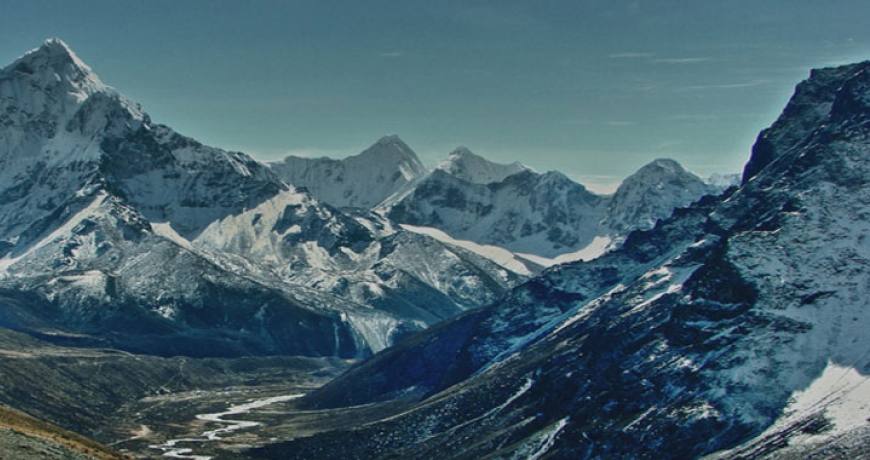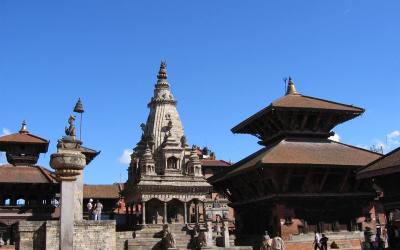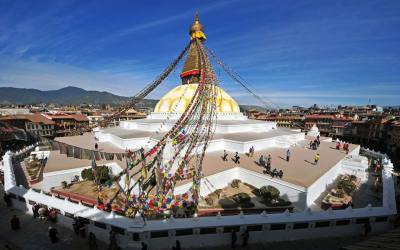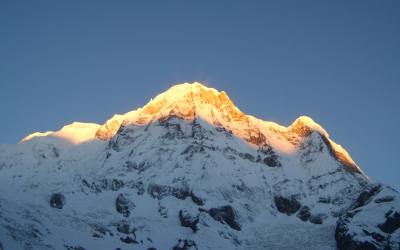Nepal Panorama Tour( Royal trek)
Day 01: Arrival Kathmandu & Transfer to Hotel in Kathmandu
Day 02: Sight seeing around kathmandu valley with English speaking culture guide and by private transport ( Kathmandu durbar square, Swoyambhunath, Boudhanath stupa, Pasupatinath, Patna durbar square)
Day 03: by private Transport to Pokhara ( 6 to 7 hours of driving)
Day 04: Trek to Tirkhedhunga (1700m)
Day 05: Trek to Ghorepani(2850m)
Day06: Trek to Tadapani(2650m)
Day07: Trek to Ghandruk village(1940m)
Day08: Trek to Nyapul than to Pokhara
Day09: Sight seeing around pokhara valley with culture guide
Day10: By private transport to Bandipur Hill resort (3 hour of driving)
Day11, 12, : By private transport to Chitwan national park.(3-4 hour of driving)
Day13: Return back to Kathmandu valley. The journey will take5-6 hour of driving
Day14: Sight seeing tour to Bhaktapur city and Chagu Narayan Temple
Day15: Tour Ends
Day01: Arrival and Transfer to Hotel in Kathmandu.
Upon arrival in Kathmandu, you are met at the airport and transferred to your hotel. Our airport representative will be holding a play card with your name at arrival hall. The drive from the airport to the hotel is around 20 minutes.
Day02: Sight seeing around Kathmandu valley by private car with English speaking guide
(Hanuman Dhoka Kathmandu durbar square)
It is the historic seat of royalty. The Durbar Square, with its old temples and palaces, epitomizes the religious and cultural life of people. It is here that kings of Nepal are crowned and their coronations solemnized. Interesting things to see here are, Taleju temple built by king Mahendra Malla in 1954 AD, the temple of Kal Bhairab , the god of destruction, Nautale durbar, the statue of King Pratap Malla, the big drum and the Jaganath temple. It was listed in the UNESCO world heritage monument list in 1979.
On the right hand corner, a large wooden lattice screen hides an enormous gilded face of Sweta Bhairab. The screen is removed only during the Indra Jatra festival.. there are also the Numismatic museum and Tribhuban museum inside the Hanuman Dhoka palace building . Photography is prohibited inside the museums. Both the mseums remain closed on Tuesday and government holidays.
Swoyambhunath ( Monkey Temple)
This is one of the world‘s most glorious Buddhist Chaityas. It is said to be 2,000 years old. Painted on the four sides of the spire’s base are the all seeing eyes of Lord Budhha. It is 3Km west of Kathmandu city and it situated on a hillock about 77 m commands an excellent view of the Valley. This stupa is the oldest of its kind in Nepal. It was listed in the UNSCO world Heritage Monument List in 1979.
Bouddhanath Stupa
The stupa of Baudhanath lies 8 km east of Kathmandu. This ancient colossal Stupa is one of the beggest in the world. It was listed in the UNESCO world Heritage Monument List in 1979.
Pasupatinath Temple( Hindu Temple)
Situated 5km east of kathamandu, the temple of Lord Shiva, Pashupatinath, with two tired golden roof and silver door is considered one of the holiest for Hindus. Although only Hindus are allowed inside the temple, visitors can clearly see the temple and the activites performed in the Temple premises from the eastern bank of the Bagmati river. The Temple was listed in the UNESCO world heritage Monument List in 1979
Patan Durbar Square
The ancient city of Patan, lying 5 km southwest of kathmandu, is known as the city of fine arts, The city is full of Hindu temples and Buddhist monuments. The diversity of the medieval culture that allowed both Hinduism and Buddhism to flourish has left a rich legacy of impressive sightseeing in this city for today’s visitors.
Patan Durbar Square:
Situated in the heart of the city, constitutes the focus of visitor’s attraction. The square is full of ancient palaces, Temple and shrines, noted for their exquisite carvings. The Patan durbar Square consist of three main chowks or countryards, the Central Mul Chowk,
Sundari Chowk and Keshar narayan Chowk, The Sundari Chowk holds in its center a masterpiece of stone architecture. The Royal Bath called Tushahity. It was listed in the UNESCO world Heritage Monument list in 1979.
Krishna Mandir:
Built in 1637 AD, the temple of Lord Krishaa holds a commanding position in the palace complex of Patan. It is supposed to be the first specimen of Shikhara style architecture in Nepal. It is the only temple in Nepal having 21 spires and is completely 21 spires and is completely mad of stone.
Day03: By private transport to Pokhara
The drive will take approxmate 7 hours. by air it will take only 45 minate. at the afternoon visit lake side and ready for trek for next day. over night at hotel in pokhara.
Pokhara is set in a lovely valley at the foot of the Machapuchare so you get spectacular views of the mountains from all parts of the town. It is quite different from Kathmandu, with few temples, but it does have plenty of scenic attractions and is close to the mountains. There are some interesting short walks or bicycle rides from Pokhara, you can swim and canoe on Lake Phewa or just watch the last rays of the sun stream across the dip in the mountains that hold the lake. Along the lakeside road there is a continuous stretch of small hotels, restaurants and shops; it’s an area which still has a bit of the old hippy scene feel about it.
Day04: Pokhara to Nyapul by private transport than trek to Tirkhedhunga (1700m)
After breakfast take a bus ride to Nyapul(trek starting point) for one hour than trek to Birethanty for 30minates where trekking permit and national park permit will be checked. The trail continues along the Bhurungdi Khola pasing through small villages and water fall you will reach a small village called Tirkhedhunga. Where you will spend a nights.
Day05:Tirkhedhunga to Ghorepani(2800m)
After crossing the suspension bridge over the Bhurungdi Khola, you will have to start a steep ascent to Ulleri( 2073m)using a continues stone steps. This is the hardest ascent in this course. From Ulleri trail continues gradually uphill through small village and Rhododendron forest you will be in Ghorepani.
Day06:Ghorepani/ Poon hill to Tadapani ( 2650 m)
Rise early to climb up Poon Hill to watch a magnificent sunrise over the Himalayas. We then continue to Tadapani, trekking through open grassland and deep forests. On the way there are excellent views of Annapurna South and the Manaslu range. Approx 6 hours trekking
Our trail today is one of the most glorious imaginable. First we rise early to climb Poon Hill for the most incredible sunrise that you will ever see. The views are the same as the previous afternoon but the sunrise adds a further dimension and many travellers will consider this to be one of the main highlights of the trip. We return to Ghorepani for breakfast before continuing, climbing steadily through rhododendron forest. The forest clears every so often, providing absolutely beautiful views of the Dhaulgiri Massif.
Once we have reached the top of the ridge we continue on a stunning ridge walk through the forest with lovely views of Dhaulgiri poking through the trees. We then start to descend and continue downhill through jungly forest, with moss covered trees, thick foliage and lianas hanging down. We follow the river as it leaps and jumps down waterfalls, and continue down for several hours. After a final ascent we then arrive in
Tadapani where we stay in a teahouse with stunning views of Annapurna South, Machapuchare and down the valley to the horizon.
Day07: Tadapani to Ghandruk village( 1940m)
Trail continues down hill through forest for 4hours to reaching Ghandruk village. This is the village of Gurungs, where the path of annapurna sanctuary branches off.
Day08: Ghandruk/ Nyapul to Pokhara
Walking down hill through stone path for one hour and haif hour you will reach to Modi khola. From here trail continues through bank of river to reach to Nyapul. From here by private transport to pokhara.
Pokhara is a remarkable place of natural beauty. Situated at an altitude of 827m from the sea level and 200km west of Kathmandu valley, the city is known as a center of adventure with several beautiful lakes and offers stunning panaromic views of Himalayan peaks.
The serenity of lakes and the magnificence of the Himalayas rising behind them create an ambience of peace and magic. So today the city has not only become the starting point for most popular trekking and rafting destinations but also a place to relax and enjoy the beauty of nature.
Pokhara is part of a once vibrant trade route extending between India and Tibet. To this day, mule trains can be seen camped on the outskirts of the town, bringing goods to trade from remote regions of the Himalaya. This is the land of Magars and Gurungs, hardworking farmers and valorous warriors who have earned worldwide fame as Gurkha soldiers. The Thakalis, another important ethnic group here, are known for their entrepreneurship.
The climate of Pokhara is slightly warmer than Kathmandu with daytime temperature hovering around 15 degrees Celsius in winter and 35 degrees in summer. The monsoon season which lasts from mid-June to mid-September is very wet; in fact Pokhara records the highest rainfall in the country. Best time to visit is between October and April.
The activities of foreign visitors to Pokhara focus around two districts known as Damside and Lakeside (or Pardi and Baidam, in Nepali, respectively). These two areas, with their strips of hotels and restaurants, are a few kilometers south-west of the main Pokhara bazaar.
Day09: Sight seeing around pokhara valley with English speaking guide and by private transport.
Beautiful Pokhara valley
The beauty, they say, lies in the eyes of a beholder. That might be true to something beautiful, but what you want to tell about something sublime. If there is something that challenges Biblical Garden of Eden in its splendor and magnificence, it’s Pokhara – the ultimate destination for the wanderlusts and those who appreciate, of course, beauty in its pristine glory.
The enchanting valley of Pokhara valley is situated at an altitude of 827 meters from sea level. An incarnation of the religious heaven, this celestial city is also known as the “city of seven lakes”. Just 200 kilometers west of Kathmandu, it is linked by Air and by road from Kathmandu and the Indian border Sunauli. Pokhara offers magnificent views of Dhaulagiri, Fishtail, Manaslu, five peaks of Annapurna and others. This is one of the few places in the world to provide such a dramatic view in a sub-tropical setting. The nearest
snow-capped mountain, Fishtail, is less then 30 kilometers from Pokhara. Pokhara’s numerous lakes offer fishing, boating and swimming.
Sarangkot
The view of the Annapurna Himalaya from Sarangkot is almost a religious experience. From here, you can see a panoramic sweep of Himalayan peaks, from Dhaulagiri (8167m) in the west to the perfect pyramid that is Machhapuchhare (6997m) and the rounded peak of Annapurna II (7937m) in the east. Most people come here at dawn or dusk, when the sun picks out the peaks in brilliant colours.
Fewa lake
Fewa Lake, the second largest lake in the Kingdom, is the center of attraction in Pokhara. It is the largest and most enchanting of the three lakes that add to the resplendence of Pokhara.
Mahendra cave
Another of nature’s wonders in Pokhara is the Mahendra Gupha. This large limestone cave is locally known as the House of Bats, an apt name for it. A two-hour walk to the north of Pokhara, it is best to bring your own torch to see the stalactites and stalagmites, as well as the local winged residents.
Seti River
Another of Pokhara’s natural wonders that unfailingly interests visitors is the Seti river. Flowing right through the city, this river runs completely underground at places. Amazingly, at certain points the river appears hardly two meters wide. But its depth is over 20 meters! Mahendra Pul, a small bridge near the old MissionHospital, provides a perfect view of the rivers’s dreadful rush and the deep gorge made by its powerful flow.
Barahi Temple
The Barahi temple is the most important monument in Pokhara. Built almost in the center of Phewa Lake, this two-storied pagoda is dedicated to the boar manifestation of Ajima, the protectress deity representing the female force Shakti. Devotees can be seen, especially on Saturdays, carrying male animals and fowl across the lake to be sacrificed to the deity.
Museum
The Pokhara Museum, located between the bus stop and Mahendra Pul, reflects the ethnic mosaic of western Nepal. The lifestyles and history of ethnic groups such as the Gurung, Thakali and the Tharu are attractively displayed through models, photographs and artifacts. One major attraction is a display highlighting the newly-discovered remains of an 8000-year-old settlement in Mustang.
Open daily, except Tuesdays and holidays, from 10 am to 5 pm
Devi’s Fall
Locally known as the Patale Chhango (Hell’s Fall). Devi’s Fall (also known as Devin’s and David’s) is a lovely waterfall lying about two km south-west of the Pokhara airport on the Siddhartha Highway. Legend has it that a trekker (Devin, David..) was washed away by the Pardi Khola and disappeared down into an underground passage beneath the fall.
Day10: Pokhara to Bandipur Hill resort by private transport ( 1030 m) 3 hours of driving
After breakfast take a drive to Bandipur Hill resort. which is 75 k.m. from Pokhara. the drive will take around 3 hrs.
Bandipur
A tiny village with spectacular view of mountains, Bandipur is located in Tanahu district about 140KM from Kathmandu. This is the best hill station to view mount everest, Bandipur’s hallmark is its beautiful scenery. At the eastern part of the town is the pagoda roofed Bindabashini temple which houses goddess Durga, Bandipur’s guardian deity. The rich wooden carvings and detailed brass-work that adorn the temple are replicas of those found in the many old pagoda structures of the kathmandu valley. The other important temples and shrines in the vicinity include the Mahalaxmi temple with its exquisite woodwork and the Khadga Devi temple which comes alive once a year during the Dashain festival.
Day11, 12, : Bandipur to Royal Chitwan national park by private transport (3and haif hour of driving)
Jungle Safari in NepalNepal is a land of extreme contrasts in climate and geography. It has a unique topography ranging from lowlands with sub-tropical jungles to arctic conditions in the Himalayan highlands. Within a mere 150 kilometers, the land rises from near sea level in the south to over 8,000 meters in the north. This together with the monsoon rainfall along the south facing slopes has resulted in compacting virtually all climate zones found on planet earth. as result , Nepal has been endowed with the great diversity of life- zones providing a home for a large variety , birds and animals.
Terai lowland is the richest habitat with the tall grasslands interspersed with reverie and hardwood sal forest. Here one can see wild life such as the swamp deer, musk deer, black buck, blue bull, and the Royal Bengal tiger, Gharial and mugger crocodiles, and the last breed of Asiatic wild buffalo. This area is also rich in birdlife with verity of babblers and orioles, Koles and drongos , peacocks and floricans, and a multitude of wintering wildfowl.
Once the famous big game hunting areas in Asia , Chitwan National park now offers protection to a large array of mammals such as the one- horned rhinoceros, tiger , leopard, sloth bear and the gaur ( wild bison ) as well as more then 400 species of birds
First day
On your arrival at Chitrasari you will be received by our staff. You will then be transferred to our Resort where you will be offered refreshments & be given a briefing on our Resort & its facilities. After being given your programe for the day, your room will then be allocated to you.
1:00- Lunch.
15:00 - Elephant briefing & bathing.
16:00 - Elephant safari. An excellent opportunity to see four different kinds of deer, rhinoceros, wild boar, monkeys, leopard, sloth bear and the Royal Bengal Tiger (if you are lucky). You will also encounter many other smaller mammals that have made Chitwan their home.
19:00 - Thaw cultural dance presentation (which you can also participate in) by the local villagers or a slide show presentation on almost everything under the Chitwan sun.
20:00 - Dinner.
Second day: Activities at inside the park (Elephant back ride, jungle walk, canoe trip, tharu stick dance and Elephant wash).
05:30 - Wake up call.
06:00 - Tea/coffee followed by nature walk. An excellent opportunity to see a great many of those 524 different species of birds found in Chitwan.
07:50 - Breakfast.
09:00 - Canoe ride along the Rapti river. An excellent opportunity for bird watching and for seeing the 2 rare species of crocodiles; the Marsh Mugger and the fish eating Gharial.
10:00 - Visit to the Government Elephant Breeding Center. Walk/drive back through the Tharu villages to our Resort where you can take a leisurely swim or relax by the poolside. You can also spend the time before lunch to gaze at the fishes found in Chitwan in your own fish pond or play a game of tennis or pool table with your friends or just spend a few quiet moments in our library with a book. You can even let your children play by themselves in our children’s playground. Your choices are limitless.
13:00 - Lunch.
15:00 - Visit to the National Park Visitor’s center where you can learn more about the history of the National Park and about wildlife.
16:00 - Village tour to a nearby ethnic Thaw village where you will learn more about the life and lifestyles of the Thaws.
19:00 - Tharu cultural dance presentation or a slide show presentation.
20:00 - Dinner.
Day 13: Drive back to Kathmandu. The journey will take 5 to 6 hours.
05:30 - Wake up call. Tea/coffee followed by elephant safari, nature walk or you can just spend the morning as you prefer.
07:30 - Breakfast.
09:00 - Departure for Kathmandu and return back to same hotel.
Day14: Sight seeing tour to Bhaktapur city and Chagunarayan Temple
Bhaktapur is lying at 12 KM east of capital city Kathmandu. Bhaktapur is "the city of Devotees". It is locally known as "Khwopa and Bhadgaon" which is world renowned for its elegant art, fabulous culture , colourful festivals, traditional dances and indigenouslifestyle of different people of different religion. For its majestic monuments, temples and the native typical newar lifestyle best known for their long history of craftsmanship, the ancient city is also variously known as the " City of Culture ", "Living Heritage " , "Nepal’s Cultural Gem " and "An open museum". Given such unequaled opulence in ancient art and culture, Bhaktapur is more like an open museum, and the ambiance here is such that it instantly transports visitors back by centuries. This conch shaped hostoric city is spreading over an area of 6.88 square KM at 1,401 meters above sea level, which was founded in the 12th century by King Anand Dev Malla.Bhaktapur was the capital city of the Greater Malla Kingdom till the 15th century AD. The many of Bhaktapur’s greatest monuments were built by thethen Malla rulers.
The ancient ritual dances and festivals are still observed by the locals with the same fervour and ehthusiasm as their ancestors did centuries ago. King Yaksha Malla (15th ventury) heavily fortified this city. Bhaktapur has its gem in Durbar Squareand Changu Narayan temple-- a World Heritage site listed by the UNESCO. Strewn with unique palaces, temples and monasteries best admired for their exquisite artworks in wood, metal and stone, the palatial enclave has bewitched pilgrims and travelers for centuries.Yet, they are not all though. Stretching all along the township, the panoramic Himalaya levitates in the skyline as if to keep vigilance on the city’senviable beauty and splendor.It grows from a collection of villages strung along the old trade route between India and Tibet.
Changu Narayan:
Situated at the end of a long ridge which runs well into the Valley, It is said to have been built by king Hari Dutta in 323 AD said to be the oldest temple in the valley. It was listed in the UNESCO world Heritage Mountain list in 1979.
Day15: Tour Ends (Departure for onwards destination)
Price per person US$1150.00 or Euro 840.00
Single supplement US$150.00 or Euro 110.00
DEPARTURE DATES ARE ON THE REQUEST
Every additional night hotel in kathmandu or in pokhara will cost US$ 30.00 for double room with bed and breakfast and US$ 25.00 for single room.
Hotel we use in this tour
Kathmandu Prince Hotel
Thamel, Chhetrapati, kathmandu, Nepal,Tel : 4255961, 4255282, Fax : 977-1-4255282
E-Mail : [email protected] Website : www.kathmanduprincehotel.com
Or
Potala Guest House
Thamel, chetrapati, Kathmandu, Tel : 4226566, 4220467
Email: [email protected], Website : www.potalaguesthouse.com
Hotel we use in Pokhara
pokhara village Resort
Lakeside, Pokhara, Nepal,Phone: 061-462427
Email: [email protected],[email protected], www.pokharavillage.com
or
Hotel Kantipur
Lakeside, Pokhara, Nepal, Phone: 977-61-460286, 461004, 464705,Fax: 977-61-464806
Website:- www.hotelkantipur.com
Hotel we use in Chitwan national park
Tiger residency resort
Sauraha, Chitwan,Tel: 0977-56-580053
www.tigerresidency.com
Or
Unique wild resort
website: www.uniquewildresort.com
Hotel we use in Bandipur
Bandipur Mountain resort
http://www.islandjungleresort.com.np/view.php?resort=bandipur-mountain-resort&pageid=5
What’s Included
- Airport pick up and drop by private transport (international flight)
- 4 night hotel in kathmandu at tourist standard hotel with Bed and Breakfast
- ( centrally located, room with attach bathroom and hot and cold shower)
- 2 full day sight seeing tour around kathmandu valley with English speaking guide.
- 3 night hotel in pokhara at standard hotel with Bed and Breakfast
- ( Centrally located , room with attach bathroom and hot and cold shower)
- 1day sight seeing tour around pokhara valley with English speaking guide.
- All the ground transportation by private transport
- 4 night 5 days trekking in lodge ( Lodges are simple but clean Enough and has a hot and cold shower)
- Sleeping bag and down jacket for trekking
- Kit bag for to put personal clothing and equipment
- Annapurna park permit with Tims card ( we need two photograph each for permit)
- An experience trekking guide trained by ministry of tourism and one porter for every
- Two client ( price will include their salary, meals, transportation, equipment and insurance)
- Trekking map for Annapurna region.
- First aid kit box
- 1 night hotel in Bandipur mountain resort with Bed and Breakfast
- 2 night hotel in chitwan with all the meals ( Breakfast, lunch and Dinner)
- All the activities at chitwan national park ( such as Elephant back ride, jungle walk, jeep drive, canoe trip, visiting elephant breeding center, culture dance and Elephant wash)
- Nature guide with all the entrance fees at chitwan national park
- All the government tax
- English speaking guide for entire tour
What’s not Included
- Personal bar bill, travel insurance/International airfare/Domestic airfare.
- Items of personal expenses such as alcoholic drinks, cold drinks, laundry, tips for trekking staffs and hotels etc.
- Nepal entry visa fee US$ 40 (duration 30 days from date of issue)- Available at Royal Nepalese Embassies and Royal Nepalese Consulates abroad or on arrival at Tribhuvan International Airport in Kathmandu.
- All the entrance fees of temple in Kathmandu and Pokhara valley
- All the meals beside chitwan national park ( Allow US$ 20 per person per day. it is good enough for lunch and dinner and drinks)
- Tipping for trekking guide, trekking porter, driver and for tour leader



